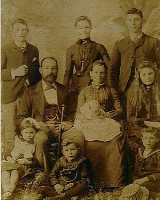
John George Gough
Encyclopedia
John George Gough was one of the founders of the New South Wales
Labour Party
, initially the Labour Electoral League, the first political Labour movement in Australia. He was also one of Labour’s five-member leadership group when the party first made its appearance in the New South Wales parliament in 1891. Representing Young
, he was first elected in 1889 to the parliament’s lower house as a member of the Protectionist Party
, which produced Australia's first two prime ministers, Edmund Barton
and Alfred Deakin
. From 1891 to 1894 he represented Labour. Proud that he was a second-generation Australian on his mother’s side, he was a strong nationalist and republican
.
One of the pioneer
s of the Young
-Grenfell
district, he began his working life as a miner and also became a successful contract builder, leaving a fine legacy of public buildings across New South Wales. He was also a Methodist lay preacher – all but one of the 35 founding elected members of the New South Wales Labour Party were devout Methodists.
Descended from transported convicts on both sides, and orphaned at the age of 13, he was a self-made man.
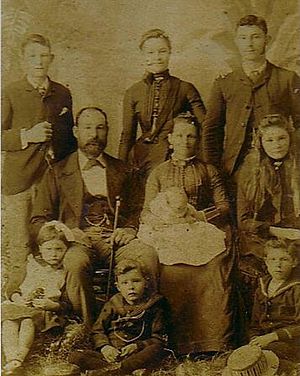 Gough was of English ancestry on his father’s side and Irish, both Protestant and Catholic, on his mother’s. He was a second-generation Australian on his mother’s side.
Gough was of English ancestry on his father’s side and Irish, both Protestant and Catholic, on his mother’s. He was a second-generation Australian on his mother’s side.
While according to Gough’s death certificate he was born at Mount Egerton, Victoria
, he referred in a parliamentary speech to having been born in Melbourne. His christening entry describes his father, also John George Gough, as a stock-keeper of Darebin Creek, today Heidelberg in north-east Melbourne.
John George Gough senior was christened in 1807 at West Lavington, Wiltshire
, England, and English census returns of his twin brother William show that he was born at the nearby hamlet of Littleton-Pannell. In 1824 he was sentenced to death for stealing a horse. But King George IV commuted the sentence to seven years’ transportation, and he arrived in Sydney in 1825.
John George Gough senior married Sarah Jane Bruce at Melbourne’s (Church of England) St James’s Church in 1845. She was born around 1826 in New South Wales, probably in the Sydney area, the daughter of John Bruce and Catherine Kelly. Both had been transported Irish convicts. John Bruce, a millwright born in Newry
, County Down
, in about 1792, to a Presbyterian family, was sentenced in Dublin in 1814 to seven years’ transportation for stealing a watch, and arrived in Sydney the following year. Catherine, a Catholic born around 1798 probably in Dublin, was sentenced there in 1815 to fourteen years’ transportation for attempting to pass a forged banknote.
According to a published biographical sketch of Gough when he entered the New South Wales parliament, his mother Sarah died when he was an infant. When his father died at Lambing Flat (later renamed Young) in September 1862, he was a butcher. He may have also been a gold-rush digger - a John Gough was one of the 3,394 signatories of the February 1861 miners' petition at Lambing Flat seeking government assistance to prevent Chinese gold-diggers competing with the Europeans.
John Gough senior died by 'taking an overdose of strichnine'. The coroner's report which might explain the reason has not survived. The day after his death, the local Burrangong Courier had no explanation for the event: `A man of the name of John George Gough, an old colonist, who occupied a butcher's shop adjoining Myers' cordial manufactory in Main Street, committed suicide yesterday morning by swallowing strychnine. He was in the Diggers' Theatre, apparently in excellent spirits, on the previous night, and no one now can tell what led to the sad act. Gough was a widower, and leaves a young son who is now unprotected, and for whom we now appeal to the sympathies of the generous in order that he may be enabled to earn an honest living.
‘The lad determined to find employment; and as a new rush, known as the ‘ten mile’ broke shortly afterward, he obtained his first employment there. A year later he decided to try his luck as a miner, and began work on the old ‘Three Mile’, known so well in the Young district. This occupation he followed with varying success for a period of twelve years. He was one of the first to try his luck at Grenfell and other gold rushes.
Five years later, finding gold-mining a precarious occupation, he abandoned it and turned his attention to the building trade, first as a journeyman and for years later as a contractor on his own account.
 This proved highly remunerative, and Mr Gough has pursued it with the greatest success in Young and its neighbourhood. Among the large contracts carried out by him may be mentioned: the new courthouse Young (costing £13,000); railway station buildings Young (£14,000); Cowra railway station and water supply (£7,000), and new courthouse, Corowa (£10,000) Two years ago he took a partner into the building trade (a Mr Holworthy). They erected a large steam saw-mill and joinery works near the goods sheds, Young, and also run a brick factory. Mr Gough has always taken an active part in local politics, having been a member of the various progress committees of Young before it was incorporated.
This proved highly remunerative, and Mr Gough has pursued it with the greatest success in Young and its neighbourhood. Among the large contracts carried out by him may be mentioned: the new courthouse Young (costing £13,000); railway station buildings Young (£14,000); Cowra railway station and water supply (£7,000), and new courthouse, Corowa (£10,000) Two years ago he took a partner into the building trade (a Mr Holworthy). They erected a large steam saw-mill and joinery works near the goods sheds, Young, and also run a brick factory. Mr Gough has always taken an active part in local politics, having been a member of the various progress committees of Young before it was incorporated.
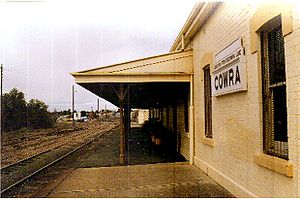 He was also one of the prime movers in obtaining the incorporation of the borough, and was elected as one of the first aldermen. Mr Gough was one of the first to introduce steam power for sluicing purposes into the Young district.... Mr Gough came forward at the late general election at the express request of the working classes, with which he has been hitherto so largely identified: and as such and as a protectionist he defeated Mr Gordon, the popular free trade candidate.’
He was also one of the prime movers in obtaining the incorporation of the borough, and was elected as one of the first aldermen. Mr Gough was one of the first to introduce steam power for sluicing purposes into the Young district.... Mr Gough came forward at the late general election at the express request of the working classes, with which he has been hitherto so largely identified: and as such and as a protectionist he defeated Mr Gordon, the popular free trade candidate.’
According to his obituary in Young’s Burrangong Argus, John Gough built a further courthouse, at Cooma. According to the same newspaper, he first entered politics while engaged in its construction. To return from Cooma to Young for the 5 February 1886 local elections there, it noted that he accomplished the 180-mile journey in two days with the same pair of horses, ‘a feat which would take a great deal of beating’ .
John Gough also built Grenfell’s Methodist church and was said to have been ‘a very prominent and able’ prayer leader and lay preacher for the Primitive Methodist Church at Young. Records show him working as a Methodist preacher from 1866 - when he wasn’t older than eighteen - to 1879.
John Gough married Martha Ann Clift at Grenfell in 1869. She was the daughter of free settlers who had emigrated from Suffolk
in 1853 and settled in the Young district in the early 1860s. Martha's father Joshua was a farmer and, like John Gough, was a Methodist preacher in the Young district. Martha bore John eleven children between 1870 and 1892.
In the 1889 New South Wales elections, Gough, as a protectionist, defeated the sitting Freetrade Member of the Legislative Assembly (MLA), J.A. McKinnon. He remained an MLA until July 1894. The NSW governments at this time were the Freetrade (conservative) administrations of Henry Parkes
and Sir George Dibbs
.
In parliament he was a strong proponent of protectionist and Australian nationalist and republican views. But he seems to have fallen out with the Labour Party. According to his obituary in the Grenfell Record, he declined to sign the party’s pledge in the 1894 election — i.e. to accept caucus decisions — ‘for conscientious reasons’, ‘even though he favoured nearly every plank in their platform’. John Christian Watson, later to become Australia’s first Labor Prime Minister, replaced Gough as Labour’s MLA representative for Young.
Descendants recall that children at the school taunted the Gough children after their father lost his seat in Parliament with ‘Goughs, Goughs, fallen toffs’.
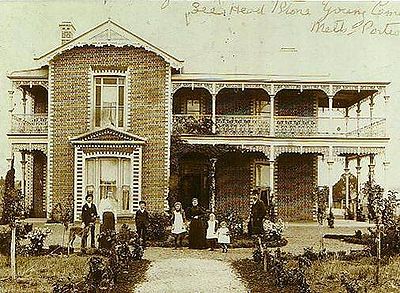
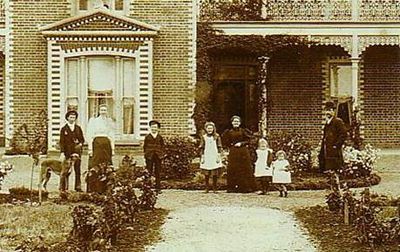 During his time as an MLA he constructed a grand residential villa, Mildon Hall, which overlooked Young and his courthouse. The house’s name was probably a reference to Mildenhall, Suffolk
During his time as an MLA he constructed a grand residential villa, Mildon Hall, which overlooked Young and his courthouse. The house’s name was probably a reference to Mildenhall, Suffolk
, where John’s wife, Martha Clift, was born. She bought the land in 1892, and the villa seems to have been constructed around November 1893. The property was sold in 1906. The building was again sold in 1920, and became the core of a Roman Catholic nursing home, today known as Mount St Joseph’s Nursing Home. The house has been substantially and unsympathetically altered.
According to his obituary in the Burrangong Argus, after his parliamentary career, he retired from the Young community ‘and returned to his old love by again attaching himself to mining pursuits. Just after the Wyalong rush broke out, he became associated with a large cyanide plant on that field, and from that day until his death was associated with mining ventures, seeking reward at Yalgogrin, Cooma, Yambulla and other places, the dredging plant at Craigie being one of his last investments.’
Indeed he appears to have moved around extensively in his final years. According to the Australian Heritage Places Inventory, in the early 1890s he bought the Cullinga gold mining operation near Wallendbeen in Cootamundra shire. His name then appears as the occupier of land adjacent to the Little Bog River at Quinburra near Craigie on a 1902 map. On the 1903 electoral roll, described as a mining manager, he appears with his wife and daughter Effie at Yambulla, another remote area straddling the NSW-Victorian border between Bombala
and Eden
. In 1906, he appears on the electoral roll at the equally remote Cowra Creek, north-east of Cooma.
He died on 15 November 1907, according to newspaper reports at his residence ‘Quinburra’, Craigie NSW. According to his obituary, on 5 November (his 59th birthday) ‘...whilst engaged at the dredging plant at Craigie, near Bombala - of which he was part-owner and manager - (he) was struck by the nozzle of one of the pipes connected with the dredge. He was taken home, and though for some time he suffered a great deal of pain, his suffering gradually eased. No fears were entertained of any fatal result, but on Friday night Death came with an awful suddenness’.
Directories from the time indicate that there were two houses in the Craigie area called ‘Quinburra’. One survives — but not the house in which John Gough lived. There are ruins on John Gough’s former land, probably of the other ‘Quinburra’.
John Gough was buried in the Methodist section at Delegate
cemetery, where his headstone survives.
Adding that he was respectfully known as ‘Jack’ Gough to his many friends, the Burrangong Argus obituary commented on his enthusiasm for public matters, his militancy, strong determination, courageous opinions, and skills as a platform speaker, including a ‘fine ringing voice’ and ‘command of emphatic language which he expressed fluently’. Obituaries were also carried in the Young Chronicle and the Grenfell Record.
A reminiscence written about John George Gough by the Young Chronicle on the occasion of the death of his widow in 1927 recalled that he was known for his jovial disposition, and was rarely seen without a cigar.
New South Wales
New South Wales is a state of :Australia, located in the east of the country. It is bordered by Queensland, Victoria and South Australia to the north, south and west respectively. To the east, the state is bordered by the Tasman Sea, which forms part of the Pacific Ocean. New South Wales...
Labour Party
Australian Labor Party
The Australian Labor Party is an Australian political party. It has been the governing party of the Commonwealth of Australia since the 2007 federal election. Julia Gillard is the party's federal parliamentary leader and Prime Minister of Australia...
, initially the Labour Electoral League, the first political Labour movement in Australia. He was also one of Labour’s five-member leadership group when the party first made its appearance in the New South Wales parliament in 1891. Representing Young
Electoral district of Young
Young was an electoral district for the Legislative Assembly in the Australian state of New South Wales in the Young area. It elected two members between 1880 to 1894 and one member from 1894 to 1904, when it was replaced by Burrangong. Young was recreated in 1927 and abolished in 1981.-Members for...
, he was first elected in 1889 to the parliament’s lower house as a member of the Protectionist Party
Protectionist Party
The Protectionist Party was an Australian political party, formally organised from 1889 until 1909, with policies centred on protectionism. It argued that Australia needed protective tariffs to allow Australian industry to grow and provide employment. It had its greatest strength in Victoria and in...
, which produced Australia's first two prime ministers, Edmund Barton
Edmund Barton
Sir Edmund Barton, GCMG, KC , Australian politician and judge, was the first Prime Minister of Australia and a founding justice of the High Court of Australia....
and Alfred Deakin
Alfred Deakin
Alfred Deakin , Australian politician, was a leader of the movement for Australian federation and later the second Prime Minister of Australia. In the last quarter of the 19th century, Deakin was a major contributor to the establishment of liberal reforms in the colony of Victoria, including the...
. From 1891 to 1894 he represented Labour. Proud that he was a second-generation Australian on his mother’s side, he was a strong nationalist and republican
Republicanism in Australia
Republicanism in Australia is a movement to change Australia's status as a constitutional monarchy to a republican form of government. Such sentiments have been expressed in Australia from before federation onward to the present...
.
One of the pioneer
Settler
A settler is a person who has migrated to an area and established permanent residence there, often to colonize the area. Settlers are generally people who take up residence on land and cultivate it, as opposed to nomads...
s of the Young
Young, New South Wales
-Demographics:On census night, 7 August 2001, there were 6,821 people counted in Young. There were 238 people who identified as being of Indigenous origin in the 2001 Census...
-Grenfell
Grenfell, New South Wales
Grenfell is a country town in the Central West of New South Wales, Australia, in Weddin Shire. It is 370 kilometres west of Sydney and five hours' drive from the city. It is close to Forbes, Cowra and Young. At the 2006 census, Grenfell had a population of 1,994.-History:Prior to European...
district, he began his working life as a miner and also became a successful contract builder, leaving a fine legacy of public buildings across New South Wales. He was also a Methodist lay preacher – all but one of the 35 founding elected members of the New South Wales Labour Party were devout Methodists.
Descended from transported convicts on both sides, and orphaned at the age of 13, he was a self-made man.
Background

While according to Gough’s death certificate he was born at Mount Egerton, Victoria
Mount Egerton, Victoria
Mount Egerton is a town in Victoria, Australia. The town is located in the Shire of Moorabool Local Government Area, north west of the state capital, Melbourne. At the 2006 census, Mount Egerton had a population of 215....
, he referred in a parliamentary speech to having been born in Melbourne. His christening entry describes his father, also John George Gough, as a stock-keeper of Darebin Creek, today Heidelberg in north-east Melbourne.
John George Gough senior was christened in 1807 at West Lavington, Wiltshire
West Lavington, Wiltshire
West Lavington is a village and civil parish in Wiltshire, England.West Lavington is located on the A360 road between Devizes and Salisbury in Wiltshire, five miles south of Devizes. The village was originally known as Bishops' Lavington....
, England, and English census returns of his twin brother William show that he was born at the nearby hamlet of Littleton-Pannell. In 1824 he was sentenced to death for stealing a horse. But King George IV commuted the sentence to seven years’ transportation, and he arrived in Sydney in 1825.
John George Gough senior married Sarah Jane Bruce at Melbourne’s (Church of England) St James’s Church in 1845. She was born around 1826 in New South Wales, probably in the Sydney area, the daughter of John Bruce and Catherine Kelly. Both had been transported Irish convicts. John Bruce, a millwright born in Newry
Newry
Newry is a city in Northern Ireland. The River Clanrye, which runs through the city, formed the historic border between County Armagh and County Down. It is from Belfast and from Dublin. Newry had a population of 27,433 at the 2001 Census, while Newry and Mourne Council Area had a population...
, County Down
County Down
-Cities:*Belfast *Newry -Large towns:*Dundonald*Newtownards*Bangor-Medium towns:...
, in about 1792, to a Presbyterian family, was sentenced in Dublin in 1814 to seven years’ transportation for stealing a watch, and arrived in Sydney the following year. Catherine, a Catholic born around 1798 probably in Dublin, was sentenced there in 1815 to fourteen years’ transportation for attempting to pass a forged banknote.
According to a published biographical sketch of Gough when he entered the New South Wales parliament, his mother Sarah died when he was an infant. When his father died at Lambing Flat (later renamed Young) in September 1862, he was a butcher. He may have also been a gold-rush digger - a John Gough was one of the 3,394 signatories of the February 1861 miners' petition at Lambing Flat seeking government assistance to prevent Chinese gold-diggers competing with the Europeans.
John Gough senior died by 'taking an overdose of strichnine'. The coroner's report which might explain the reason has not survived. The day after his death, the local Burrangong Courier had no explanation for the event: `A man of the name of John George Gough, an old colonist, who occupied a butcher's shop adjoining Myers' cordial manufactory in Main Street, committed suicide yesterday morning by swallowing strychnine. He was in the Diggers' Theatre, apparently in excellent spirits, on the previous night, and no one now can tell what led to the sad act. Gough was a widower, and leaves a young son who is now unprotected, and for whom we now appeal to the sympathies of the generous in order that he may be enabled to earn an honest living.
Miner, builder, preacher, politician
John George junior's life following his father's death was described as follows in the Town and Country Journal when he entered parliament:‘The lad determined to find employment; and as a new rush, known as the ‘ten mile’ broke shortly afterward, he obtained his first employment there. A year later he decided to try his luck as a miner, and began work on the old ‘Three Mile’, known so well in the Young district. This occupation he followed with varying success for a period of twelve years. He was one of the first to try his luck at Grenfell and other gold rushes.
Five years later, finding gold-mining a precarious occupation, he abandoned it and turned his attention to the building trade, first as a journeyman and for years later as a contractor on his own account.


According to his obituary in Young’s Burrangong Argus, John Gough built a further courthouse, at Cooma. According to the same newspaper, he first entered politics while engaged in its construction. To return from Cooma to Young for the 5 February 1886 local elections there, it noted that he accomplished the 180-mile journey in two days with the same pair of horses, ‘a feat which would take a great deal of beating’ .
John Gough also built Grenfell’s Methodist church and was said to have been ‘a very prominent and able’ prayer leader and lay preacher for the Primitive Methodist Church at Young. Records show him working as a Methodist preacher from 1866 - when he wasn’t older than eighteen - to 1879.
John Gough married Martha Ann Clift at Grenfell in 1869. She was the daughter of free settlers who had emigrated from Suffolk
Suffolk
Suffolk is a non-metropolitan county of historic origin in East Anglia, England. It has borders with Norfolk to the north, Cambridgeshire to the west and Essex to the south. The North Sea lies to the east...
in 1853 and settled in the Young district in the early 1860s. Martha's father Joshua was a farmer and, like John Gough, was a Methodist preacher in the Young district. Martha bore John eleven children between 1870 and 1892.
In the 1889 New South Wales elections, Gough, as a protectionist, defeated the sitting Freetrade Member of the Legislative Assembly (MLA), J.A. McKinnon. He remained an MLA until July 1894. The NSW governments at this time were the Freetrade (conservative) administrations of Henry Parkes
Henry Parkes
Sir Henry Parkes, GCMG was an Australian statesman, the "Father of Federation." As the earliest advocate of a Federal Council of the colonies of Australia, a precursor to the Federation of Australia, he was the most prominent of the Australian Founding Fathers.Parkes was described during his...
and Sir George Dibbs
George Dibbs
Sir George Richard Dibbs KCMG was an Australian politician who was Premier of New South Wales on three occasions.-Early years:Dibbs was born in Sydney, son of Captain John Dibbs, who disappeared in the same year...
.
In parliament he was a strong proponent of protectionist and Australian nationalist and republican views. But he seems to have fallen out with the Labour Party. According to his obituary in the Grenfell Record, he declined to sign the party’s pledge in the 1894 election — i.e. to accept caucus decisions — ‘for conscientious reasons’, ‘even though he favoured nearly every plank in their platform’. John Christian Watson, later to become Australia’s first Labor Prime Minister, replaced Gough as Labour’s MLA representative for Young.
Descendants recall that children at the school taunted the Gough children after their father lost his seat in Parliament with ‘Goughs, Goughs, fallen toffs’.


Mildenhall, Suffolk
Mildenhall is a small market town and civil parish in Suffolk, England. It is run by Forest Heath District Council and has a population of 9,906 people. The town is near the A11 and is located north-west of county town, Ipswich. The large Royal Air Force base, RAF Mildenhall as well as RAF...
, where John’s wife, Martha Clift, was born. She bought the land in 1892, and the villa seems to have been constructed around November 1893. The property was sold in 1906. The building was again sold in 1920, and became the core of a Roman Catholic nursing home, today known as Mount St Joseph’s Nursing Home. The house has been substantially and unsympathetically altered.
According to his obituary in the Burrangong Argus, after his parliamentary career, he retired from the Young community ‘and returned to his old love by again attaching himself to mining pursuits. Just after the Wyalong rush broke out, he became associated with a large cyanide plant on that field, and from that day until his death was associated with mining ventures, seeking reward at Yalgogrin, Cooma, Yambulla and other places, the dredging plant at Craigie being one of his last investments.’
Indeed he appears to have moved around extensively in his final years. According to the Australian Heritage Places Inventory, in the early 1890s he bought the Cullinga gold mining operation near Wallendbeen in Cootamundra shire. His name then appears as the occupier of land adjacent to the Little Bog River at Quinburra near Craigie on a 1902 map. On the 1903 electoral roll, described as a mining manager, he appears with his wife and daughter Effie at Yambulla, another remote area straddling the NSW-Victorian border between Bombala
Bombala, New South Wales
Bombala is a town in the Monaro region of south-eastern New South Wales, Australia, in Bombala Council. It is located approximately south of the state capital, Sydney, and south of the town of Cooma. The name derives from an Aboriginal word meaning "Meeting of the waters". The town lies on the...
and Eden
Eden, New South Wales
Eden is a coastal town in the South Coast region of New South Wales, Australia. The town, south of the state capital Sydney near the border with Victoria, is located between Nullica Bay to the south and Calle Calle Bay, the northern reach of Twofold Bay, and built on undulating land adjacent to a...
. In 1906, he appears on the electoral roll at the equally remote Cowra Creek, north-east of Cooma.
He died on 15 November 1907, according to newspaper reports at his residence ‘Quinburra’, Craigie NSW. According to his obituary, on 5 November (his 59th birthday) ‘...whilst engaged at the dredging plant at Craigie, near Bombala - of which he was part-owner and manager - (he) was struck by the nozzle of one of the pipes connected with the dredge. He was taken home, and though for some time he suffered a great deal of pain, his suffering gradually eased. No fears were entertained of any fatal result, but on Friday night Death came with an awful suddenness’.
Directories from the time indicate that there were two houses in the Craigie area called ‘Quinburra’. One survives — but not the house in which John Gough lived. There are ruins on John Gough’s former land, probably of the other ‘Quinburra’.
John Gough was buried in the Methodist section at Delegate
Delegate
A delegate is a person who speaks or acts on behalf of an organization at a meeting or conference between organizations of the same level A delegate is a person who speaks or acts on behalf of an organization (e.g., a government, a charity, an NGO, or a trade union) at a meeting or conference...
cemetery, where his headstone survives.
Adding that he was respectfully known as ‘Jack’ Gough to his many friends, the Burrangong Argus obituary commented on his enthusiasm for public matters, his militancy, strong determination, courageous opinions, and skills as a platform speaker, including a ‘fine ringing voice’ and ‘command of emphatic language which he expressed fluently’. Obituaries were also carried in the Young Chronicle and the Grenfell Record.
A reminiscence written about John George Gough by the Young Chronicle on the occasion of the death of his widow in 1927 recalled that he was known for his jovial disposition, and was rarely seen without a cigar.

